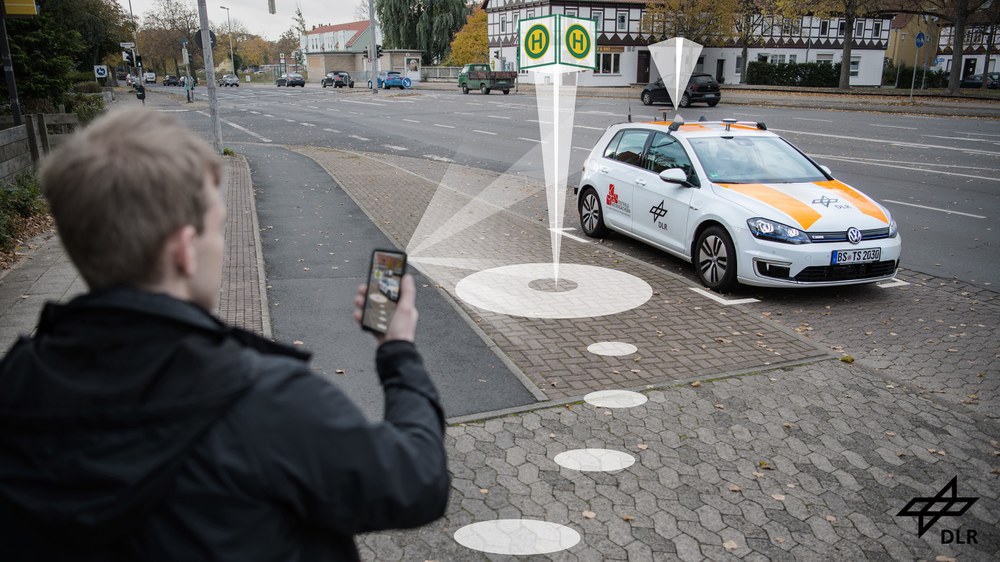SAMOD and vStop HMI: Intelligent mobility through augmented reality
- User-centred mobility through SAMOD: Shared Automated Mobility On-Demand (SAMOD) combines highly automated shuttles with demand-oriented journey bundling to create mobility-friendly services for users.
- Virtual stops (vStop): Flexibly defined pick-up points that do not require visible markings in public spaces are a key concept for SAMOD systems. They act as a virtual transport infrastructure to coordinate all participants in pick-up scenarios.
- Orientation through AR technology: A human-machine interface (HMI) with augmented reality helps passengers to find their vStop easily and identify automated shuttles quickly - especially in complex or confusing situations.
- Benefits for passengers and operations: Efficient vStop solutions can increase the acceptance and usability of SAMOD services and improve service quality and user-friendliness.
- Focal points: Augmented reality, human-machine communication, new mobility solutions
The world of mobility is on the brink of fundamental change. Concepts such as Shared Automated Mobility On-Demand (SAMOD) show how sustainable and user-friendly solutions are becoming possible. SAMOD uses highly automated shuttles that bundle the journeys of different passengers according to demand. The shuttles operate autonomously and flexibly based on current demand, enabling efficient use of resources and offering an alternative to private transport. Innovative approaches such as virtual stops (vStop) further optimise operations, as passengers can get on and off at dynamically defined points – without any fixed stops, timetables or routes.
The use of vStops is a central element of this mobility service. Unlike conventional stops, they do not require any physical infrastructure in public spaces, but instead enable flexible pick-ups at strategically selected locations. To help passengers find these stops quickly and intuitively, a new type of human-machine interface (HMI) has been developed: the vStop HMI, which uses augmented reality (AR) to offer a new dimension of orientation and support on the mobile device.
SAMOD: Sustainable mobility with shared automated shuttles
The SAMOD concept could become a key element for the future of urban mobility. It combines:
- automated vehicles that transport people safely and efficiently,
- demand-responsive services that make journeys more flexible and cost-effective by transporting several people with similar destinations at the same time, and
- virtual stops that require neither space nor complex structural measures in public spaces and serve as a virtual transport infrastructure for coordinating participants in pick-up scenarios.
Compared to private transport, this approach not only reduces road traffic and the associated emissions, but also fundamentally rethinks mobility – as a service.
The challenge: How do passengers find the virtual stops?
A key feature of SAMOD is the elimination of traditional stops and the introduction of virtual alternatives. These offer more flexibility, but require passengers to walk short distances to reach their pick-up point. During the waiting time, they virtually "meet" the shuttle and get on where it is most convenient for the rest of the journey. This does not represent a significant change compared to conventional bus stops.
However, unlike conventional bus stops, there are no visible markings in public spaces, which poses new challenges, such as locating the stop in an unknown environment and identifying the right vehicle, especially in busy or confusing situations. This is where augmented reality comes into play.
vStop HMI: Augmented reality as the key to user-friendliness
The vStop HMI is a human-machine interface concept that was developed as an iterative prototype specifically for virtual stops. With the help of AR, relevant information is displayed directly in the passenger's environment.
The vStop HMI offers three main advantages:
Firstly, a visual orientation aid on the mobile device that shows the route to the virtual stop.
Secondly, the spatial localisation of the arriving shuttle – particularly helpful in complex scenarios with several identical vehicles, without any communication with a driver.
Thirdly, the intuitive operation ensures a low cognitive load and an overall positive user experience.
Conclusion: vStop HMI, SAMOD and AR pave the way for the mobility of tomorrow
The integration of augmented reality into new mobility concepts such as Shared Automated Mobility On-Demand shows how modern technologies can make the mobility of tomorrow more user-friendly. The vStop HMI significantly improves service quality and increases the acceptance of automated mobility services.
These innovations are not only creating a more efficient transport system - they are also paving the way for a new type of mobility: intelligent, flexible and sustainable.

